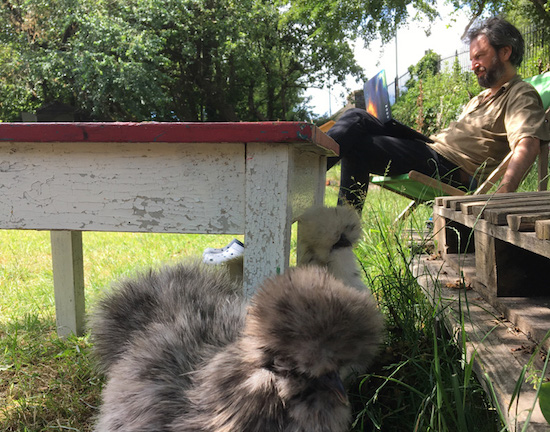All pictures by Lorna Ritchie and Mark Pilkington
Teleplasmiste’s To Kiss Earth Goodbye is at number 72. on tQ’s Albums Of The Year So Far chart
Throughout my life I’d imagined myself living with a menagerie of animals, like my cool aunt, or literary heroes Ivan T Sanderson and Daniel P Mannix, but four decades living in London had made that a distant dream. Now I live in rural Wiltshire and I have chickens. This is their story.
Something Special
So why chickens? They make great animal companions – they’re soothing, friendly, fiercely curious, always entertaining and occasionally very stupid. Get hens, and they also come with a near-lifetime’s supply of free eggs. The initial outlay is about the cost of a small synthesiser (perhaps an Arturia Microbrute), but chickens make beautiful sounds that no synthesiser can – believe me I’ve tried – and not even a Moog Matriarch will provide you with fresh eggs every morning.
We have four hens, who lay two to four relatively small eggs a day, more than enough for a family of three-and-a-bit to make omelettes, pancakes, baked goods, and just eggs; and to give a six-pack to friends every now and again. Because the hens are free roaming and eat everything from grain pellets to earwigs, their eggs are a much richer colour than those you get in a supermarket, which can initially be alarming. On rare occasions, if the chickens are stressed or hot, the eggs may also have soft shells, which is positively Cronenbergian, though these are still perfectly edible.
All Kinds Of People
There are hundreds of chicken species out there, though most of us have only seen the Goldlines or Leghorns usually depicted on egg cartons. Ex-battery rescue chickens are a popular choice for smallholders, and will provide large eggs, though they can require medical and emotional care as they recover from the abuses of the battery. My partner Lorna and I met a pack of Buff Pekins while collecting a local eBay purchase, free-roaming and scuttling about their garden in tight formation like the Brown Arrows. When we discovered that they also come in black, we knew we’d found our birds.
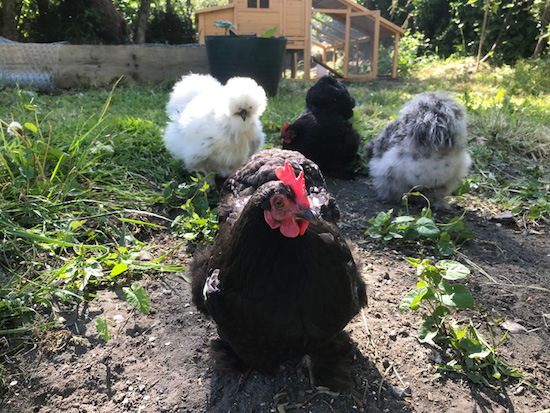
Tonight I’ll Be Staying Here With You
Before you adopt your chickens, you’ll need a coop and, ideally, a protected run attached to it, essential if there isn’t room for them to roam outside. Coops come in all shapes, styles and sizes, from plastic space capsules to mock-Tudor mansions and traditional Chicken Cottages, and there are numerous free plans online for building your own if you’re that way inclined. But whatever you get it will end up covered in chicken shit, so don’t be too precious about it. Focus on how easy it is to get inside, clean it out and retrieve eggs, as you’ll be spending a fair amount of time doing that.
You’ll need a feeder for pellets (their main source of food, especially if they’re kept inside) and a water dispenser. We’re constantly surprised at how thirsty our birds are, but when you think about all that albumen, it’s got to come from somewhere. Also essential are a plentiful supply of wood shavings, hay or straw for nest bedding and soaking up poop. Some chicken keepers don’t recommend straw and hay, especially in winter, as they aren’t very absorbent and can lead to mite infestations – an ongoing issue in some coops – but they’re easier to clear out than sawdust and should be ok if you clean the coop once a week.
Silkie The Best
Once we had a coop and run in place, we found a local farmer who had Black Pekins for sale. But we also discovered that she was selling Silkies – imagine Dr Who Yetis played by Tina Turner and Rod Stewart – and couldn’t resist their fluffy absurdity, returning home with two of each breed in a large, quietly clucking, cardboard box.
However, over the next few days it became clear that, as the bold Black Pekins strutted about, determinedly exploring their new territory, something was up with the Silkies. They just sat in balls of fluff near their food and had to be gingerly hand-lifted into the coop at night. Concerned that they were ill, we turned to the large online chicken-keeping community, only to discover that Silkies – as well as being a very ancient, (probably) traditional Chinese breed – are famously docile and, let’s not mince words, stupid. Their ridiculous pompom hairdos also make visibility an issue, leading to some human companions giving them an occasional trim.
Happily, within a couple of weeks both Silkies – Tiina Truggith and Snufl Pipslazzle – had settled in well, though we’re not convinced that they do a lot of laying. Tiina’s become a bit of a bully, aggressively pecking at the other hens if there’s any competition over food, or sometimes just for the hell of it. Snufl is always the last to go to bed at night, hanging around outside the coop like a surly teenager, until I lose patience, bundle her up and chuck her inside. I think she enjoys the drama.
The point is do your research before selecting breeds, and don’t choose a chicken just because it looks like Tina Turner.
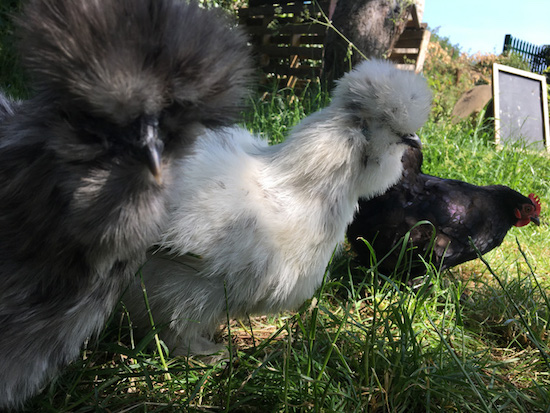
The Night Time Is The Right Time
Early to bed, early to rise, forget to lock up and everyone dies.*
Haunted by the dangers of their Jurassic past, chickens will retreat to the coop on their own volition when night falls. But they can’t lock themselves in, so unless you get a coop with a light-sensitive door closing mechanism (we didn’t), you’ll need to lock the doors and close the coop gates every night to protect the girls from predators – i.e. foxes, who can, and will, wreak mayhem if they get inside a coop, as happened to our neighbours last year. Some people might find this a chore, but I find it a fine opportunity to chat to the chickens, greet the bats and enjoy the twilight.
It’s also a good idea to remove the chicken feeder from the run at night, otherwise it may become overrun with rats, who can get so casual that they end up moving in and waddling around the coop at all hours expecting to be fed.
If you’ve locked the chickens in at night, that means you also have to release them in the morning, when they all come charging and clucking out of the coop for a gulp of water and tasty pellets. It’s a beautiful, cheering start to the day.
*Actually I did forget to lock up for the first time while writing this piece, and guess what… no one died. I consider us lucky and won’t do it again.
Shake A Tail Feather
If you attach a run to your coop, you can leave your hens inside quite comfortably. However, we chose the two Black Pekins – Moonlight Queklimoq and Dungeon Ghostly III – because we heard that they were less destructive and could be left to roam the garden without fear of them laying waste to your herbaceous borders. We were lied to.
Chickens love nothing more than to dig up the top layer of soil with a nimble one-two dance step and search for tasty morsels, like ants and their eggs, beneath. Actually there is one thing they love more and that’s eating the precious young buds on your flowers. Protect young plants with well-placed bricks or a defensive wall of chicken wire. (We thought that stuff was to protect chickens from the ravages of the outside world; in fact it’s to protect the outside world from the ravages of your chickens.)
The hens also love a dust bath, and when it’s dry enough will dig themselves into a shallow bowl in the ground for a roll around; sometimes all four of them at once. A dust-crazed chicken rolling on its back with gay abandon is a joy to behold.
Other than these Forbidden Zones, our chickens have the right to roam and spend most of their days wandering about crapping on everything. This is mostly fine, though you’ll be amazed at how large chicken poop can be. It’s great fertiliser for the garden, though less good for bare feet, plates, books, blankets etc.
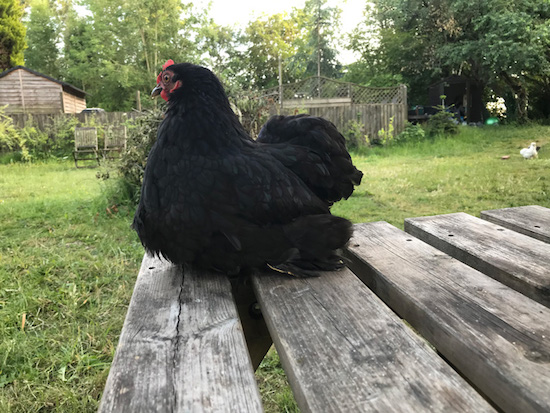
Steel Claw
All that digging does have its benefits. Chickens are great natural pest controllers, eating ticks, lice, ants, aphids, earwigs, and pretty much anything that can’t run away from them, except, disappointingly, slugs (despite a great deal of encouragement). That also includes your own snacks – bread, fruit and vegetables, mini cheddars and, yes, probably cooked chicken, though we nipped that one in the bud before it got any further. There are some things we aren’t meant to know.
Show Some Respect
Our chickens are highly social, curious creatures who clearly love each other’s company, and also seem to enjoy ours, often congregating where we are hanging out, even when there’s no food involved. They and our two cats Rupi and Sara seem to tolerate each other – we get the impression that the chucks are just too large and formidable to be considered fair game for the cats, who will sometimes creep up close to observe them, but have never pounced. Rupi has chased the Pekins on occasion, but this seems more like a misguided attempt at play than a prelude to maim and torture. I’m sure dogs can also be trained to leave chickens alone, though have no experience to report on.
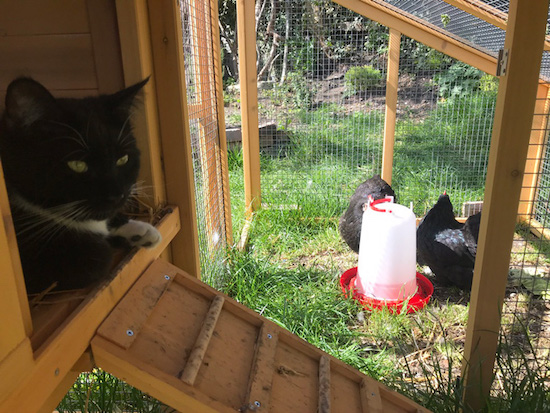
I Better Get Steppin’
We love watching the girls strutting about in pairs, or sometimes all four of them in feathery lockstep like The Golden Girls meeting The Good, The Bad And The Ugly. Occasionally one of them will leap up into the air and charge across the garden squawking loudly. We have no idea what’s happening in their tiny dinosaur minds and that’s one of the many reasons we love them.
I Can’t Stand The Rain
Actually the chickens seem mostly oblivious to rain, unless it’s tipping it down. This is Tiina in a downpour. They’re more upset by strong gusts of wind, which send them frantically charging about the place, clucking wildly.

Undercover Agents For The Blues
Our chickens only cluck when they’re agitated, say when you’re chasing them away from a tasty flower, and only squawk when they’re very angry, or sometimes to announce that they’re laying – which sounds uncomfortable. Most of the time they make a range of soothing, gently expressive and melodious sounds that make for rewarding deep listening; when relaxed they produce a continuous soft warble that rolls and ripples like water when they’re all doing it together. There are also excited chattering cheeps in the morning when they hear you approaching the coop to let them out. A particular favourite, which I think comes at moments of deep contentment such as a dust bath or a very tasty snack, is a long, throaty, low gurgle of ecstasy. An epic album of poultry-based ambience, will surely emerge once the stars are right.
I Want You Near Me
Dungeon Ghostly III, usually the pluckiest of the two Pekins, recently became broody. We thought she was ill as she wouldn’t leave the nesting box. But when Lorna took her a convalescent strawberry she hopped out and darted off with it, clearly physically fine. Later we found her sitting on four eggs, presumably not all her own. Broodiness is a mania – we shut Dungeon out of the coop for the day and she just sat on the nesting box roof waiting to get back in. It’s also contagious, which raises all sorts of questions about the social psychology of chickens. Nobody knows why it happens, but it seems to occur more in summer. Unfortunately the only cure for broodiness is to stick the poor hen in an open wire floor iso-cube for at least three days, until their body temperature cools down and the madness subsides. We borrowed our neighbours’ outdoor guinea pig hutch, now Dungeon’s dungeon, and reluctantly locked her away. And I’m happy to report that after three nights in the drunktank, Dungeon leapt straight into a celebratory four-bird dust bath, her eggmania apparently a distant memory.
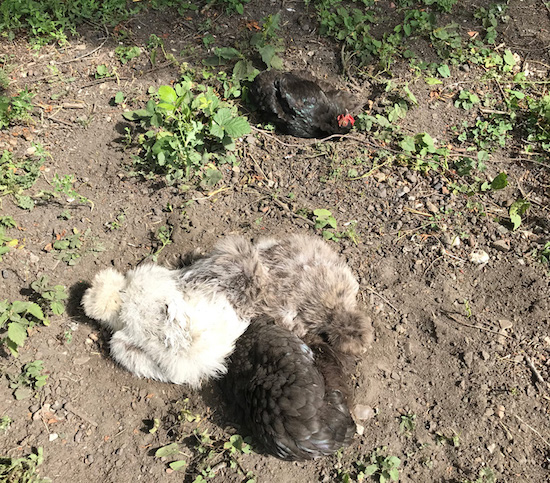
Easy As Life
After flying in on silent wings, within a few months the chickens had become a core part of our home life, comfortably occupying a space between pets and smallholding animals. We love them, and their peculiar ways, and their eggs, and often find ourselves wondering how to build a chicken swing, make Silkie headbands or just looking online at hi-viz chicken tabards. While we’re blessed with a largish garden, you don’t need a lot of space to keep hens happy, and there are several coops and runs designed for smaller, or urban, spaces; just ensure that they are sturdy enough to keep foxes out. There’s a certain amount of regular upkeep involved in cleaning the coop and maintaining the chickens’ health and safety, but no more than there is for most pets, and the surreal, Jurassic joy they’ll bring into your world is something few other warm-blooded animals can provide.
Mark Pilkington is one half of (currently-non-poultry-based) experimental electronic duo Teleplasmiste, whose new album ‘To Kiss Earth Goodbye’ is out now from House of Mythology. He also co-runs Strange Attractor Press (also non-poultry-based, though that may change)


